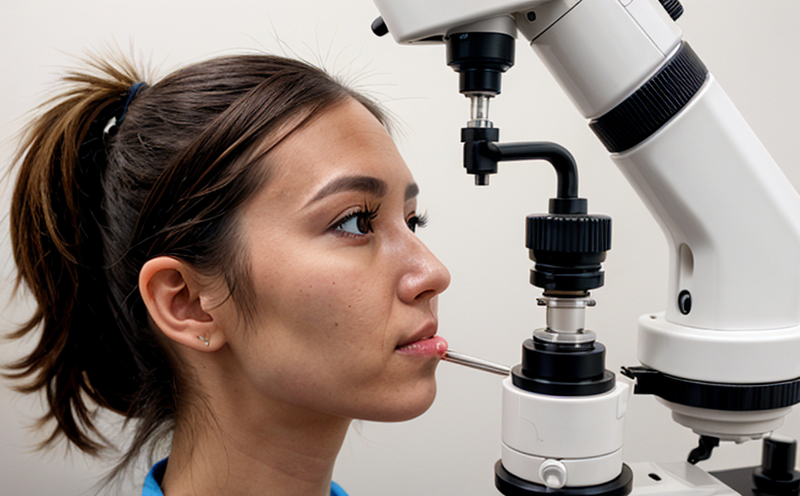ISO 11979-10 Intraocular Lens Phakic Performance Testing
The ISO 11979 series of standards provides a framework for testing various types of intraocular lenses (IOLs), including phakic IOLs, which are implanted into the eye to help restore vision. This particular test, ISO 11979-10, focuses specifically on evaluating the performance characteristics of phakic IOLs under a variety of conditions that simulate real-world usage scenarios.
The testing protocol outlined in ISO 11979-10 is designed to ensure that phakic IOLs meet stringent safety and efficacy requirements, which are critical for patient safety and regulatory compliance. The test involves several stages aimed at assessing the mechanical properties of the lens under conditions intended to mimic post-surgical environments.
During testing, specimens undergo stress-strain analysis to determine their resistance to deformation or failure when subjected to forces typical of normal ocular movements. This includes torsional loading and compressive stresses that simulate the natural physiological loads experienced by implanted lenses during daily activities such as blinking and gaze shifts.
The procedure also involves measuring the optical performance parameters, including but not limited to spherical aberration, astigmatism, and modulation transfer function (MTF), which are crucial for ensuring optimal visual outcomes post-surgery. These measurements help verify that the lens maintains its intended optical properties over time, even under adverse conditions.
A key aspect of ISO 11979-10 testing is the assessment of biocompatibility and biostability. This involves evaluating how well the lens integrates with surrounding ocular tissues without causing inflammation or other adverse reactions. The test also examines the lens's resistance to microbial growth, which is vital for preventing infections that could lead to serious complications.
Additionally, this standard evaluates the compatibility of the lens materials used in the construction of phakic IOLs. The materials must be inert and non-toxic to minimize adverse effects on the patient. This includes checking for any leachable substances or degradation products that might affect tissue health over time.
In summary, ISO 11979-10 testing is an essential component in ensuring the quality and safety of phakic IOLs before they reach the market. By adhering to this rigorous protocol, manufacturers can provide devices that are reliable, safe, and effective in improving patients' vision.
Eurolab Advantages
Comprehensive Testing Capabilities: Eurolab boasts a suite of advanced testing facilities equipped to perform ISO 11979-10 compliance checks. Our laboratory is staffed by highly qualified professionals who understand the nuances of ophthalmic device testing, ensuring accurate and reliable results.
State-of-the-Art Equipment: Leveraging cutting-edge technology, our lab offers precise control over environmental conditions required for ISO 11979-10 testing. This ensures that every test adheres strictly to the prescribed parameters set forth by international standards.
Expertise and Experience: Our team comprises experts in medical device compliance and R&D, providing deep industry knowledge tailored specifically towards phakic IOLs. This expertise translates into thorough evaluations and actionable insights for our clients.
Regulatory Compliance: With a strong focus on regulatory standards, Eurolab ensures that all tests meet not only ISO 11979-10 but also other relevant international guidelines like EN ISO 13485. This guarantees that the results are universally accepted and recognized.
Client-Centric Approach: Understanding the unique needs of our clients, Eurolab offers tailored solutions designed to meet specific project requirements. Whether it’s early-stage development or final approval testing, we work closely with you every step of the way.
Efficiency and Reliability: By streamlining processes and maintaining high standards of quality control, Eurolab ensures that your projects move smoothly through development stages towards successful completion.
Why Choose This Test
The ISO 11979-10 Phakic IOL performance testing is crucial for several reasons. Firstly, it helps manufacturers ensure that their products meet stringent safety and efficacy standards set by international bodies. By adhering to these tests, companies can demonstrate compliance with regulatory requirements necessary for product approval.
Secondly, this rigorous testing process enhances public trust in medical devices by providing verifiable evidence of product reliability and effectiveness. This builds confidence among healthcare providers who rely on accurate test results when recommending treatments to their patients.
Thirdly, ISO 11979-10 ensures that phakic IOLs are biocompatible and stable over time. This is particularly important given the long-term nature of these implants, where any adverse reactions could have severe consequences for patient health.
In addition to enhancing safety and efficacy, this test also aids in optimizing product design. By identifying potential weaknesses or areas needing improvement early on during development stages, manufacturers can refine their products before launching them into clinical use.
Furthermore, passing ISO 11979-10 testing opens up opportunities for wider market penetration by satisfying stringent quality assurance protocols required across different countries and regions. This global recognition strengthens brand reputation and fosters international collaborations within the medical device industry.
Customer Impact and Satisfaction
The impact of ISO 11979-10 Phakic IOL performance testing extends beyond mere compliance; it significantly enhances customer satisfaction through several key benefits:
Better Patient Outcomes: Ensuring that phakic IOLs meet high standards improves overall patient outcomes by reducing the risk of complications and enhancing visual acuity.
Increased Product Quality: Rigorous testing leads to higher quality products, which are more likely to perform consistently as intended. This builds trust among consumers who seek dependable medical devices for their healthcare needs.
Improved Brand Reputation: Achieving compliance with internationally recognized standards reflects positively on the brand’s reputation. It demonstrates commitment to excellence and sets a benchmark for quality within the industry.
Enhanced Regulatory Approval Prospects: Demonstrating adherence to such stringent testing protocols increases the chances of favorable regulatory decisions, thereby facilitating smoother market access processes worldwide.





